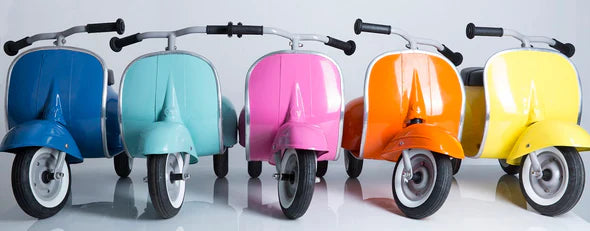This article will explain their benefits for physical development, thinking skills, and social interactions. Read on to see how these toys improve playtime and why they’re great for your child.
What Are Ride-On Cars for Kids?
Ride-on cars are toy vehicles designed for kids to drive. They are fun and resemble real cars like sports cars, jeeps, or trucks. There are three main types, each offering unique features for children's development. These include:
Push or Pull Ride-On Cars

These ride-on cars are perfect for little kids. Babies and toddlers use these cars, but they need an adult to push or pull them. Examples of these toys are wagons and toy cars with handles. Some parents even use baby strollers as ride-ons. These cars often have long handles, making it easy for parents to navigate the car. They are excellent for walks, allowing parents to take kids around the park or neighborhood.
Pedal Ride-On Cars

Pedal ride-on cars are suitable for older kids aged three to five. These cars move when kids pedal with their feet. They have a solid frame to keep kids safe during their ride. The pedals also let kids control the car’s speed and direction. Some versions also have features like functioning lights, horn noises, and adjustable seats for added realism and comfort. These features make the ride exciting and perfect for kids who can pedal well.
Electric Ride-On Cars

Electric ride-on cars are the most advanced kind. They are usually best for kids five and older. These cars run on rechargeable batteries, allowing kids to drive them without pedaling. They have steering wheels and foot pedals, so kids can just press a button to move. Many electric ride-on toys have additional features, such as operational lights or music players. Some feature a parental remote control so that parents may assist when necessary. This ride-on car can drive on different surfaces. Examples are on grass, pavement, and more, which are great for various places.
Benefits of Ride-on Cars for Kids

There are several advantages to ride-on automobiles for kids in terms of their growth. Consider the benefits for your child's development.
Motor Skills Development
Ride-on cars help kids develop motor skills. They improve both fine and gross motor skills. Fine motor skills involve small actions, like holding the steering wheel. Children learn to move their arms and legs by pressing pedals. They also turn the wheel to steer, helping refine their motor skills and coordination.
Gross motor skills involve larger movements, like controlling the car's direction. Maneuvering the ride-on car strengthens your child's gross motor skills. They learn to balance and coordinate their movements. According to a study by the National Institute of Child Health, children who use ride-on toys have better motor skills than those who don't.
Balance and Coordination
Riding a mini vehicle is like a balancing act. Kids learn to adjust their center of gravity, helping them develop a sense of balance. With each twist and turn, they improve their coordination. Hand-eye coordination is also crucial. Steering the car and avoiding obstacles helps improve this skill. Your child learns to react quickly to their environment, which is vital for future activities like sports.
Spatial Awareness
Ride-on cars enhance children's understanding of space. As they drive, they learn to measure distances and move through areas. This helps them easily grasp directions like left, right, forward, and backward. Children using ride-on toys often develop better spatial skills. These skills are important for solving problems and doing well in school.
Problem-Solving Skills
Every ride presents new challenges, like unexpected obstacles or curved paths. These situations teach children to think and find solutions. They learn to navigate around barriers or execute sharp turns. This learning process boosts their thinking abilities. It shows them that every problem can be solved. They gain resilience and sharpen their critical thinking skills, which are valuable beyond their playtime.
Social Interaction
Ride-on cars make playtime social. Kids often enjoy these toys with friends or siblings. This fun, shared activity teaches them to work together and share with each other. Strong friendships form as they play and create memories together. During play, kids practice important skills like waiting their turn and helping each other. Understanding how to give and take turns is part of this play. These moments lay the foundation for good social skills as they grow.
Boosting Confidence
Mastering a ride-on car is a big achievement. It makes your child feel proud and confident. They learn to control the vehicle, which boosts their self-esteem. When children feel confident, they are eager to try new things. This positive attitude helps them learn better. Over time, this confidence supports their growth and success in life.
Reducing Screen Time
Ride-on cars help kids spend less time indoors and encourage children to play outside and explore. It’s good for their bodies and minds to play outside, receiving vitamin D from sunlight and fresh air. This maintains their immune system and helps them develop strong bones. Children who are outside in fresh air also feel happier and more content.
Promoting Exercise
Riding ride-on cars is a good exercise for kids. It helps them use up energy and stay active, which is good for the heart and muscles. Regular exercise can also improve school performance. The Centers for Disease Control and Prevention say active kids do better in school. It makes exercise fun and fits into daily play.
Self-Reliance
Operating a ride-on car fosters independence. Children learn to explore their surroundings on their own. This freedom encourages them to make decisions and solve problems.
Responsibility
Ride-on cars help teach kids about responsibility. They learn to care for their toys, keeping them in good condition. This habit of caring for their things extends to other parts of their lives.
Safety Tips
Safety is paramount when using ride-on cars. Here are some tips to ensure your child's safety:
- Always watch children closely: Constant supervision helps prevent accidents. Adults make sure kids stay safe while playing.
- Use safety gear: Helmets and pads protect against serious injuries. They are crucial for preventing head injuries during falls.
- Pick a safe area: Ensure children play away from cars. Choose smooth, even surfaces to reduce accident risks.
- Select age-appropriate toys: Always choose toys that are suited to your child’s age and abilities. This can prevent frustration and accidents.
- Check toys often: Regularly inspect toys for loose parts or damage. This keeps them safe and prevents accidents.
These steps make ride-on toy use safer and more enjoyable. They help create a secure environment where children can have fun and develop safely.
Conclusion
Ride-on cars for kids are tools that help children grow and learn. These vehicles improve motor skills, thinking skills, and social interactions. They encourage kids to play outside and spend less time on screens. They also help children learn independence and responsibility. Parents should consider adding ride-on cars to their child's playtime to support their growth.
Consider adding a ride-on car to your child's playtime. Explore our collection of ride-on cars. Give your child endless fun and learning today!

